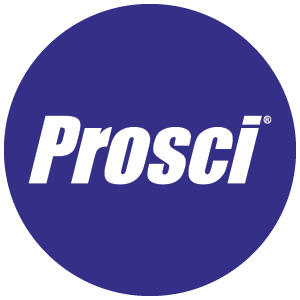How to Lead Change Management

7 Mins
Updated: August 11, 2025
Published: December 1, 2024

Leading change requires strategic vision and the ability to guide people through transitions. In times of change, leaders set the tone.
Effective Change Management Leadership
Whether you are an executive championing change from the top and aligning resources with strategic goals or a people manager translating vision into action on the front lines, you need to know what it means to lead change properly.
At Prosci, we know change done right is how organizations achieve their greatest potential. This article explains how leaders can leverage our proven methodology to build trust, inspire commitment, and navigate the complexities of organizational change.
Importance of Change Management Leadership
Organizational change is a constant force today, especially now in the digital age when whole business sectors can change overnight. Depending on your industry, you have to regularly implement new technology, reengineer processes for compliance, and look for ways to revitalize the customer experience. Through it all, one factor remains essential: people.
Your ability to support individuals in adapting to change will help your organization achieve its intended outcomes, maximize intended ROI, and sustain benefits over time. If you’re not sure where to start, use the Prosci ADKAR® Model and 3-Phase Process to your advantage. These are proven, structured approaches for managing individual transitions and scaling change across an organization.
Types of Leaders in Change Management
Real change management requires collaboration from various leadership roles within an organization. Each type of leader brings a unique perspective and set of responsibilities that contribute to executing change initiatives. From strategic visionaries to frontline supporters, understanding your role will help drive positive outcomes across your organization.
Change practitioner (or change manager)
Although they may not serve as an organizational leader, change practitioners focus on managing the people side of a transformation, which includes enabling change leaders for their critical roles. Prosci research shows that initiatives with dedicated change management resources are six times more likely to achieve their goals. By applying proven methodologies like our ADKAR Model, change practitioners provide structure and accountability, keeping change management a priority even under tight budgets and schedules.
Primary sponsor
The primary sponsor is the executive leader responsible for the change initiative. For over 25 years, our research, Prosci Best Practices in Change Management, has shown that active and visible sponsorship is the top contributor to success. Sponsors provide the authority and credibility needed to drive commitment, influence other leaders, and establish the importance of change across the organization.
Sponsorship coalition
If you are the primary sponsor, building a coalition of your peers who collectively support the change is invaluable. A sponsorship coalition aligns the organization, creating a united front to reinforce the importance of the change initiative. If you can’t put forth unified leadership, it can send conflicting messages to employees and undermine their confidence and commitment.
People managers
People managers are on the front lines of your organization. These are the folks whose teams are directly impacted by change, making them essential communicators and coaches. Employees prefer to hear about how changes will affect them from their immediate supervisors. The attitudes and actions of people managers heavily influence the progress of change initiatives. Their support—or lack thereof—directly shapes employee engagement and commitment.
Preferred Senders of Messages

Informal leaders: change champions, ambassadors and advocates
Informal leaders extend the reach and influence of change leaders and practitioners. Change agents and ambassadors:
- Provide peer-to-peer support.
- Enhance communication by increasing the flow of information.
- Role model desired behaviors.
- Offer training and implementation support.
Our research highlights that organizations with formal change agent networks report higher success rates. These networks amplify engagement, foster ownership, and align objectives at every level.
Common Challenges in Leading Change
Leading change requires more than good intentions. Even with a strong understanding of the change management process, leaders often face significant challenges that can hinder their efforts. Here are the most common obstacles and how to address them:
1. Lack of proper tools and expertise
Few things hinder the ability of sponsors and people managers to lead change more than a lack of tools, training or expertise needed to fulfill their roles well. Without proper guidance, these critical leaders may struggle to provide the support and leadership employees need during transitions, undermining the initiative.
To avoid this, change practitioners must develop tailored plans, such as sponsor roadmaps and manager coaching frameworks, so these leaders can confidently guide their teams through change. Providing ongoing support, such as role-specific training, clear communication strategies, and practical tools goes a long way to ensure that sponsors and managers can perform their responsibilities effectively throughout the change process.
2. Lack of strong leadership and leadership commitment
As we have already discussed, leadership is of the utmost importance for any change initiative. Change efforts require consistent guidance and advocacy from the top. Executive sponsorship provides the credibility and authority needed to align teams and prioritize the change effort across your organization.
Yet challenges often arise when leaders lack a clear understanding of the value of change management. Without proper education or exposure to its benefits, executives and managers may underestimate the importance of their involvement. This can lead to weak sponsorship, and when it does, employees may question the initiative's importance, resulting in resistance, confusion and missed objectives.
To overcome this, speak their language and show results. Demonstrate the connection between effective sponsorship and measurable outcomes, such as improved adoption rates, increased ROI, and timely project delivery, so leaders understand the value of their role in driving change.
Correlation Between Effective Change Management and Success
.png?width=614&height=200&name=7X%20more%20likely%20circles-2023%20(1).png)
3. Lack of consistency and visibility in driving change
Without a clear framework, change initiatives can suffer from inconsistent execution and lack of visibility, making it difficult to sustain momentum and align your organization. Employees and stakeholders need the clarity and reassurance that only a well-defined approach can provide.
The Prosci Methodology proves invaluable here. A structured framework is another top contributor to success identified in our research. It ensures that change leaders and practitioners have the frameworks, processes and tools necessary to succeed with change. Our 3-Phase Process and ADKAR Model help organizations create a repeatable approach that establishes the foundation for managing current and future changes.
Strategies for How To Lead Change Management in the Workplace
Leading change in the workplace requires you to be intentional and strategic. This section outlines actionable strategies you can follow to prioritize and establish trust, align resources, and actively engage with employees.
Activating executives and senior leadership as leaders of change
The ABCs of Sponsorship describe the critical responsibilities of executive sponsors during times of change:
A) Active and visible participation
Leaders must remain actively engaged throughout the project, not just at its kickoff. This participation includes championing the change, allocating necessary funding, and attending key events.
B) Build a coalition of sponsorship
Change often spans multiple departments, making collaboration among leaders essential. Primary sponsors must lead the effort to build and maintain a strong coalition of influential leaders who advocate for the change across the organization. A united coalition eliminates confusion and bolsters employee confidence.
C) Communicate, support and promote the change
Employees look to senior leaders for clarity on why the change is happening and how it aligns with organizational goals. Sponsors must deliver clear, compelling messages about the benefits of the change and the risks of inaction to legitimize the change effort.
Equipping people managers as leaders of change
While executives focus on high-level strategy, people managers work directly with employees to implement and sustain change. Prosci identifies five critical roles for people managers during times of change, which we refer to as CLARC:
Communicator – People managers deliver personalized messages about the change, answering team-specific questions like, “What does this mean for us?” and “Why should I care?” By fostering Awareness, managers help employees understand the need for change and align with organizational goals.
Liaison – Acting as intermediaries between employees and project teams, managers provide feedback from their direct reports and share updates from leadership to keep employees informed and engaged.
Advocate – The visible support of people managers builds employee Desire to engage with the change. Managers influence team members’ willingness to adopt new processes or behaviors by actively demonstrating their commitment to the initiative.
Resistance Manager – Resistance is a natural response to change, but people managers are uniquely positioned to address it. Identifying root causes and offering tailored support allows you to mitigate resistance and guide teammates toward building Knowledge and Ability.
Coach – People managers act as coaches, supporting employees through their individual change journeys. They help their team succeed in new roles or processes, addressing barriers and reinforcing progress along the way.

Building internal change management capability
Invest in building internal capabilities that support leaders and employees at every level. The way to do this is twofold:
- Develop in-house expertise through comprehensive training programs. Workshops, certifications, and tailored learning opportunities equip everyone at every level with the skills and knowledge needed to lead and support change.
- Deploy a change management framework, such as the Prosci Methodology with the Prosci 3-Phase Process, to provide a consistent approach to managing change. A well-defined framework establishes clear roles, processes and tools, making it easier to scale change management practices across the organization.
Balancing leadership and people
Aligning objectives – Strategic alignment bridges the gap between leadership’s vision and day-to-day operations, guaranteeing that all departments and teams are working toward common goals. Establishing a shared vision creates a unified direction that streamlines decision-making and promotes organizational agility.
Recognizing people respond to change differently – Leaders must acknowledge and address employee differences by tailoring their support to individual needs. This might include providing additional resources, offering personalized coaching, or creating opportunities for employees to share their concerns.
Creating a safe environment with clear goals – Cultivating a safe and transparent environment encourages employees to engage with the change process. Setting clear, achievable goals helps reduce uncertainty among employees so they can navigate transitions with confidence.
Building accountability – Accountability ensures that everyone understands their role in the change process and contributes to its actualization. At the same time, leaders must create channels for open dialogue, allowing employees to express concerns, ask questions and offer feedback.
Prosci 3-Phase Process
%20thought-leadership-articles/small-3-phase-process-with-plain-language-questions%20(1)-1.png?width=800&height=568&name=small-3-phase-process-with-plain-language-questions%20(1)-1.png)
Case Studies
Global Bank: Enhancing Leadership in a Regulatory Landscape
Faced with challenges in a strict regulatory environment, a global bank partnered with Prosci to shift its focus from technical processes to people-centered change. We established an Enterprise Change Management Office (ECMO) and equipped senior leaders and people managers through certifications and workshops. Using our ADKAR Model, Prosci trained over 100 practitioners and introduced tools to integrate change management into the organization’s culture. Our efforts enhanced the bank’s change maturity and engagement among employees and led to greater adoption of key initiatives, like a cloud-based compliance tool.
Entertainment Company: Empowering Sponsors and Managers for ERP Success
Amid rapid growth, an international entertainment company addressed resistance to implement a complex enterprise resource planning (ERP) system. Prosci provided customized training for over 60 personnel and conducted sponsor briefings to build leadership alignment. Through PCT Assessments and ADKAR surveys, the team addressed risks and maintained alignment throughout the project. Tailored communications and a post-launch reinforcement plan equipped people managers and sponsors to guide employees, resulting in a beneficial ERP rollout and immediate business impacts.
Leading Change, Inspiring Success
Leading change is both an art and a science, requiring vision, strategy, and a deep understanding of how to support people through transitions. From executives setting the tone with sponsorship to people managers guiding individual employees through personal change journeys, impactful leadership is the cornerstone of all change management. Leveraging Prosci’s proven methodology alongside impactful leadership, organizations turn challenges into opportunities and achieve sustainable outcomes.
Most importantly, the key to leading change management is focusing on the people. Focusing on the people side of change will unlock your potential to achieve measurable results, innovate, and remain competitive in your industry. Whether you’re an executive sponsor, a people manager, or a change practitioner, the way you lead today will define your organization’s success tomorrow.




